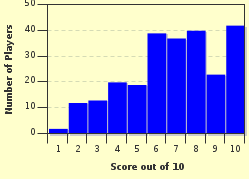Quiz Answer Key and Fun Facts
1. This person is generally recognised as the first Pope, although the title wasn't in use at the time. One of the Twelve Disciples, he died around 67 AD. Who was he?
2. Early Popes very often used their personal name as their Regnal (Papal) name. The 177th Pope, Lotario (or Lothario) dei Conti di Segni, used a Papal name which had an almost opposite meaning to the modern colloquial meaning of "Lothario". Which Pope was he?
3. Pope John XXI (1276-77) was Portuguese, a renowned scholar, and had been physician to one of his predecessors, Pope Gregory X. John's reign lasted only about eight months; what brought it to an untimely end?
4. It doesn't happen often, but a Pope can abdicate (resign voluntarily). All of these Popes abdicated; but which one actually issued the decree stating that abdication was officially acceptable?
5. In 1309, Pope Clement V (1305-14) moved the Papal seat from Rome to Avignon in France, where it remained until 1378. What was the most likely influence driving this move to Avignon?
6. The late 14th and early 15th centuries were troubled times for the Papacy. What was the Western Schism that existed from 1378 to 1417?
7. In 1483 Pope Sixtus IV (1471-84) was responsible for the appointment of a man whose name became synonymous with cruelty and callousness. Everyone expected the Spanish Inquisition; but who was this Inquisitor General?
8. A great patron of the arts and sciences, Pope Sixtus IV (1471-84) commissioned Baccio Pontelli to design a building which later became famous for its painted ceiling. Which building was this?
9. The Borgia Popes, Callixtus III (1455-58) and Alexander VI (1492-1503) were related to each other and to Cesare and Lucrezia Borgia. Which of these statements is untrue?
10. When looking at a list of Popes, you will sometimes see the letters O.S.B. following a name. What does this mean?
Source: Author
Mistigris
This quiz was reviewed by FunTrivia editor
CellarDoor before going online.
Any errors found in FunTrivia content are routinely corrected through our feedback system.

